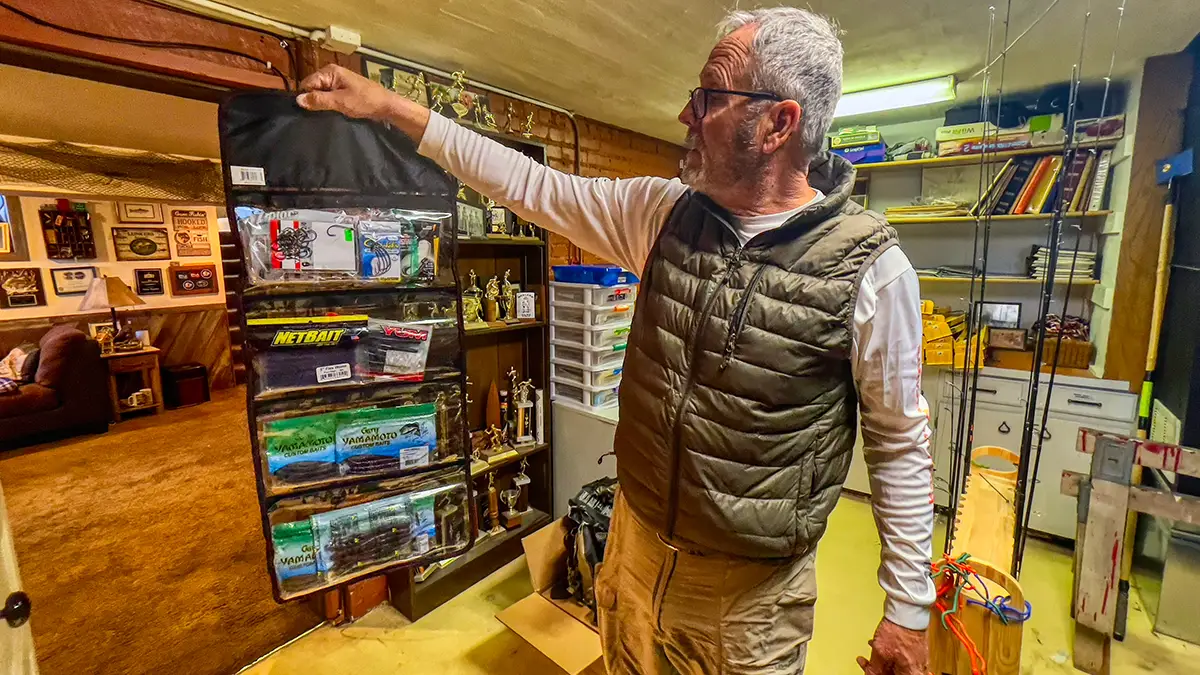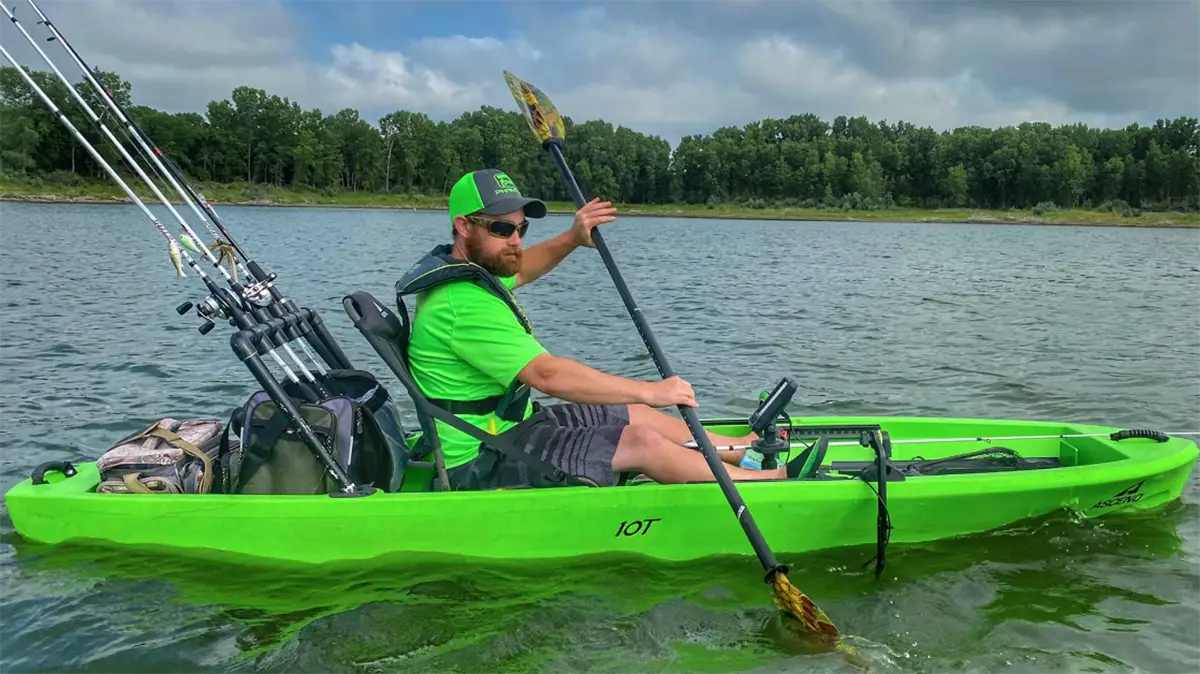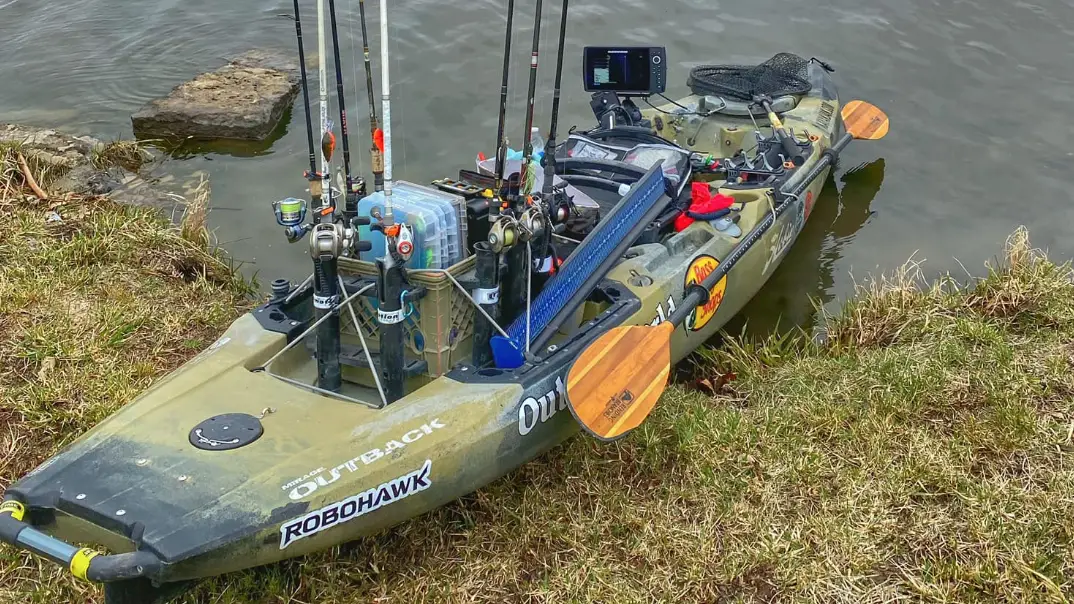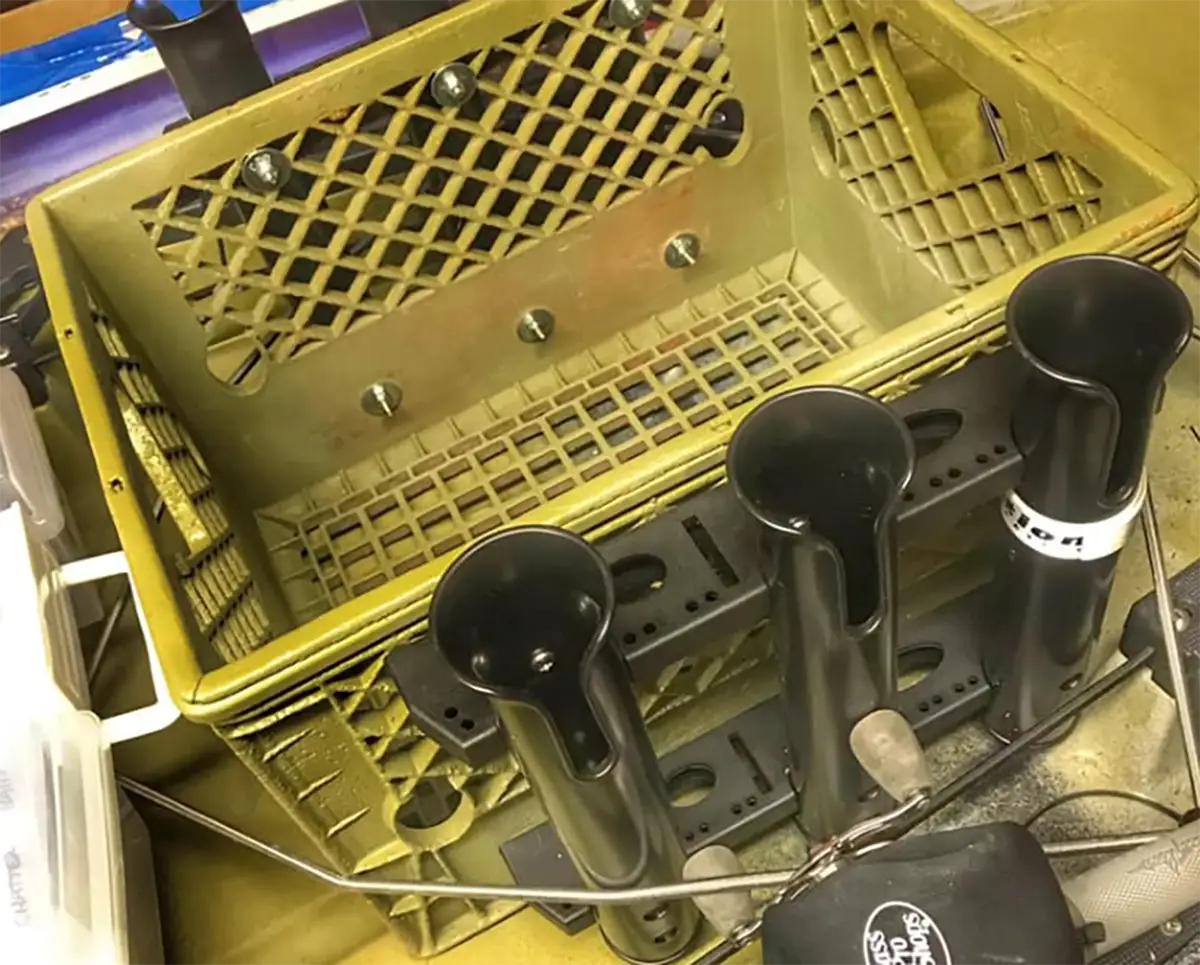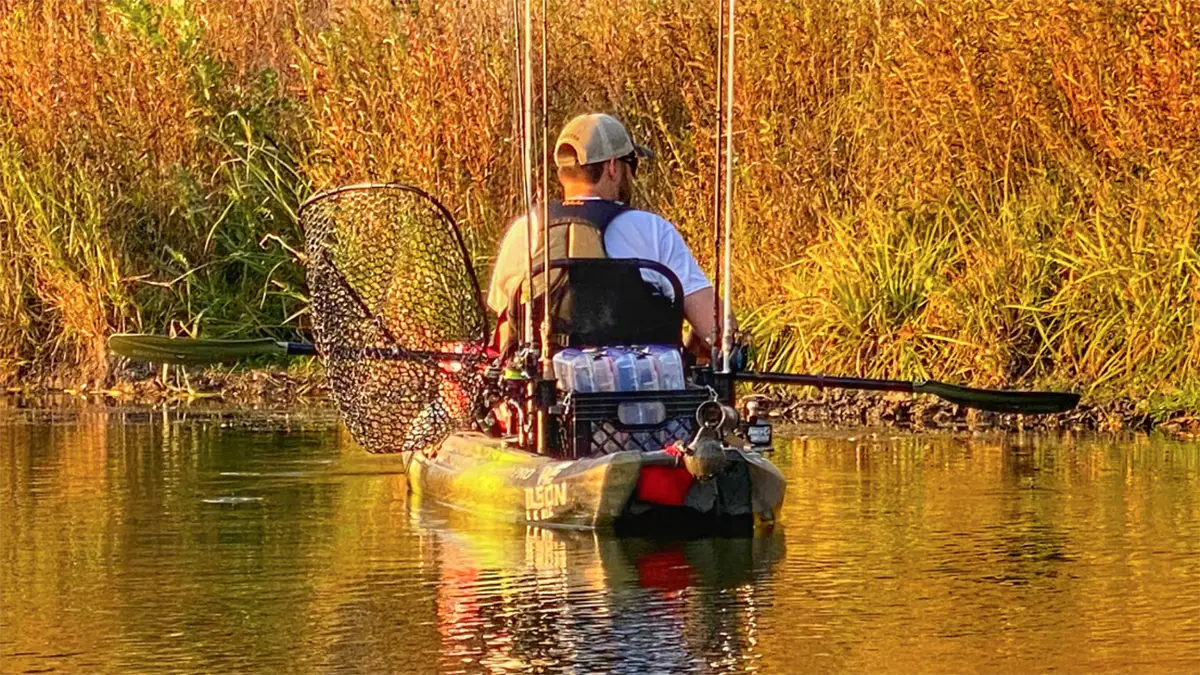Kayak fishing tackle storage has expanded and exploded into a booming market to give anglers a lot of options to pack gear smartly and efficiently. But the key is to still keep it from being to overwhelming when you get on the water. Indulge me for a second, while I take you back to the early days of my kayak fishing to explain.
With the morning fog lifting around me, I launched my kayak with a spinning combo, my net, and a small box of lures. Oh. And a pair of pliers just in case I hooked into one of those toothy critters! Birds were chirping around me and a crane nearby peered into the water at its next quick meal. The water was like glass as I glided into the backwaters of a small clearwater lake near my home.
The sheer serenity of being on the water in this fishing kayak was beyond description. I was in my most relaxed state yet anticipating that first bite that sends a primordial sensation through the body and an adrenaline rush as the fish fights to release itself from the hook.
It was a time when kayak fishing was very simple. When I started kayak fishing in the late 1990s, I found this peace and tranquility on the water with just these few items. As time went on, and I explored more waters it became a necessity to bring more rods, lures and accessories along for changing patterns and any circumstances that might arise. And now, nearly three decades later we have added graphs, cameras, lights, and even motors. There are so many gadgets and devices that we sometimes might forget what actually started us fishing from our kayaks.
Kayak fishing, thankfully, has progressed to a level where we can store numerous items on our small plastic vessels with ease. In fact, at times, I find it quite amazing they still float with all the gear we store on or in them.
Our hope here is to help you simplify your tackle storage and be more organized and efficient on the water during your kayak fishing trips.

ORGANIZE YOUR TACKLE FIRST
So you have this big mess of lures, terminal tackle, rods, reels and accessories in your garage or shop with no real organized method to take with you on the kayak. Of course, we need to decide what is going to be most useful on our kayak fishing trip to begin with. For some of us, organizing all of this tackle can actually be therapeutic in nature.
How do we get started? Well, one way is to just dump it all out onto a surface and spread it out. Then start organizing by category. For example, you might put all of your square bills in one pile, and your spinnerbaits in another. For plastics, you might have separate piles for lizards and jig trailers. After you get everything organized into specific presentations, it’s time to put it in containers that will keep it safe and in a place where you can find it easily and efficiently.
TACKLE STORAGE SYSTEM
Let’s start with the storing of your overall general tackle. The Plano Sportsman’s Tote is a great way to organize your tackle into easy to locate categories. The dimensions and with a capacity of 56 quarts these watertight plastic containers will allow you to fit lots of lures.
You can even fit three Plano Medium sized field tool boxes within these containers to further break down your categories. Labeling your storage boxes can make it even easier to locate the lures you want to use for your next trip.
Another way to organize within these crates is to use Lure Wraps and secure your plastics. They roll up nicely and you can fit quite a few snugly within the crates. If you prefer a clear plastic storage box the Plano ProLatch Stowaway Utility Box 3731 is also a great option.
SCALING DOWN TO KAYAK CARRY
So, how do I know what to take aboard my kayak? This is where doing some prior research on the body of water you are going to fish can benefit you in scaling down the amount of tackle you bring along. To do this I use a Flambeau Super Half Satchel Soft-Bait Organizer that I use as a “Game Day” box. In that organizer I stow photo case keepers that fit perfectly in it.
I purchase these cases to interchange what I am going to use on the trip. You can purchase 16 of these transparent 4” x 6” Photo Cases Keepers for under $15 online. They come in either clear or colored versions. Of course, they are not waterproof but taking a few samples of the lures you will need they work perfectly. Sometimes, I’ll place the lures in a small clear snack zip lock baggie to prevent them from getting wet and rusting. You can even take your square bills, Chatterbaits, jigs, etc. and enclose them in these boxes. For square bills I usually use those little “hair hint” rubber bands to keep treble hooks from tangling. The “Game Day” box fits easily into most kayak crates as well which we will discuss later.
As you can see below the open tray is filled with the plastics and terminal tackle I will need for a particular trip while the “Game Day” box has my hard baits in plastic cases that are labeled. This keeps things really simple for my day on the water. You can also use large gallon plastic zip lock bags, or better more rugged soft storage cases like a Plano Stowall Utility Bag or a Buzbe Fast Flatz Bait Bag.
COCKPIT STORAGE
After organizing your tackle you then have the decision of deciding where to stow it on board your kayak can be quite a process at first. It may take some trial and error to see what works best for you. Most kayaks these days provide you with areas to stow your tackle and gear. For example, the open tray above easily stores in my middle tank well on the Hobie Outback.
Along with your tackle you will need to also provide an area for your paddle, pliers, dry bag, milk crate, 360 light, net, sonar, and camera if you are using any of these items. If you are using an inflatable PFD you will most likely need to find places for your whistle, line cutters, and any other items you usually attach or store in a conventional PFD with zippered pockets and clip-on areas.
If using any accessory that requires batteries you will also need a space for these as well. And, finally a place to store your rods when not in use.
THE CRATE
Most anglers place a “milk” or “yak crate” in the rear tank well of their kayak to hold the bulk of their fishing gear. Let’s talk about the crate. Some refer to this removable storage area as the “Kayak Crate” or “Yak Krate.” This crate can be an ordinary milk crate or a marketed version like the YakAttack “Black Pak” or the Wilderness Systems “Kayak Krate.”
Some crates have a lid that secures your baits and accessories from getting wet during rain or splashing water when navigating through rough seas.
The crate below was purchased on E-bay several years ago for just five bucks and even has a metal rim. You can find similar Crates on Bass Pro for like $10. I added the Yak-Gear rod holders and painted it to match my kayak. Of course, this crate is open so your gear stored in it will most likely get wet unless it is in a dry bag.
Using the elastic straps in the rear tank well you can easily secure your crate and load it with rods. Clips were added to secure the fishing rods.
The “Black Pak” created by the Yak Attack Company is a purposefully built storage system designed with indestructible plastic panels. This crate is very durable with predrilled holes to attach rod holders and any other accessories you might need. The lid shuts tight with easy locking clips to hold it in place. The kit includes three rod holders, but more can be added in a variety of positions
The Wilderness Systems “Kayak Krate” features two separate compartments for small and large items. The smaller compartment has a clear plastic lid that is water resistant. The kit includes four rod holders and the crate includes a bracket so the crate will fit in smaller tank wells. For keeping your gear cool and dry, this crate will offer the best protection.
Flambeau makes a nice Kayak Tuff Krate as well.
On a budget? Some anglers simply use a 56 quart Plano tub in the rear tank well of their kayak. Just about anything that holds gear will work though.
Most items like batteries, plastics, and first aid kit, are usually stored below the deck. Most kayaks have a hatch that is water tight with a compartment below. Many items can be stored here.
UP RODS OR DOWN RODS
Depending on your preference and where you are fishing can depend on whether you want your rods in the up position or stored horizontally on the kayak. Some kayaks have tubes and brackets with elastic latches to secure your rods.
Be sure to have your rods secured with safety clips on a lanyard or clip.
When fishing docks, standing timber, and trees, you might consider the rods in a down position. They can also be placed in the kayak crate rod holders and clipped for security. Some anglers even set their rod holders at an angle like Lake Lorimer in Southwest Nebraska.
Strategically placing your accessories on your kayak can make things more efficient and safe as you enjoy a day of fishing. You want your paddle to be within arms reach for effective maneuvering. Your sonar unit should also be within reach to change settings when needed.
Some anglers set it up in the middle of the deck while others prefer to have it on a gunnel.
You also want to have your pliers by your side at all times and on a leash so you don’t lose them to the drink.
Whether you take a little or a lot of equipment out with you on the kayak, keeping it organized for efficient use will make your fishing trip a whole lot better. The main thing is to keep things simple so that you can enjoy the day.
